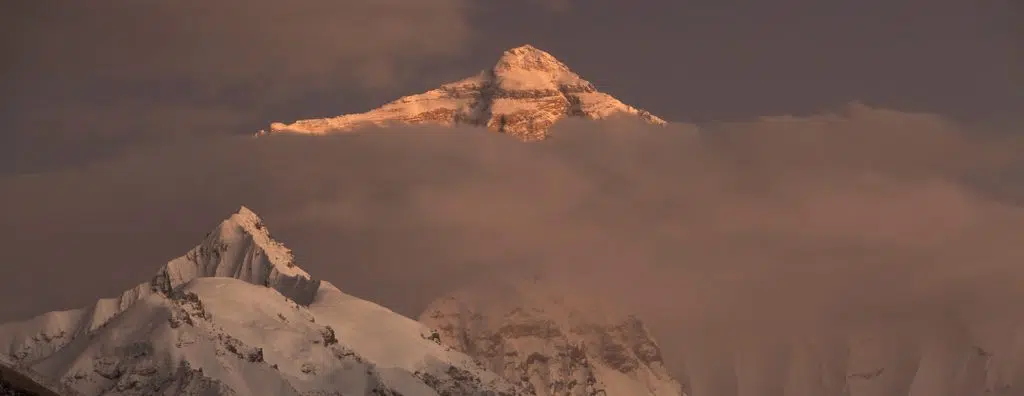Everest Three Ways
Mt. Everest has a universal appeal. It is the highest point on the planet. It also represents the physical aspect of the heights of human achievement. And though the summit has been reached thousands of times, climbers continue to scale this famous of all mountains, and trekkers visit the basecamps both north and south.
See our Everest itinerary.
The fascination about Everest is not just for climbers. Travelers approach from the northern Tibetan side via vehicle to near the Rongbuk glacier. Tourists take the Everest view flight from Kathmandu for a glimpse of the peak out of a plane window. Trekkers make their way to basecamp in the Solu-Khumbu district of Nepal. They follow the well-worn trail up the Dudh Kosi past Namche and Tengboche. Many consider a trip to the Himalaya incomplete without at least the sight of Everest.

We spoke with Sanjay Saxena, Nomadic Expeditions Director of Operations and the 2019 Condé Nast Himalaya Travel Expert. We wanted to get his insights on Everest and advice on the best way to visit Everest for non-climbers. His years of Himalayan experience go from the far west in Ladakh, Nepal in the mid-Himalaya, to Bhutan in the east. He has hiked several times to the South (Nepal) and North (Tibet) basecamps.

Sanjay described three different ways to approach Everest for trekkers, two from Tibet and one from Nepal. Following are excerpts from our conversation with Sanjay. He spoke about all three itineraries.
“South Face Base Camp (Nepal) this is the most popular trekking route, and it was from this side that Everest was first climbed. This trek is also the longest and perhaps the most strenuous hiking option of the three, with lots of up and down, but rewarding. There are plenty of opportunities for cultural exchange with the Sherpa community during the trek. The route is through their homeland with lots of views of majestic snow-clad peaks. This is also the most comfortable of trekking routes in terms of overnight accommodation as there are good mountain lodges along the way with welcoming Sherpa hosts. View a time-lapse video from base camp here:
The itinerary begins with a flight from Kathmandu to Lukla where we begin trekking. 16-days in country is my recommendation, including 12 days of hiking. It is possible to cut a few days out by flying out by helicopter and thus eliminating the last days off of the return hike. Accommodation is in mountain lodges throughout the region with heated common rooms and hot showers.
Best time is April, May (this is when climbs are happening and possible to meet climbers) and then in the Fall starting in October into the first week of December. I do not recommend going July-September as that is the monsoon season and trails can be dangerously wet. Also the peaks are usually obscured by clouds.
North Face Base Camp (Tibet) is the shortest of the three treks as we are able to drive all the way to 16,000 feet before we start hiking. This route is the same first explored in the late 19th century. It is where the first and all unsuccessful attempts to climb the mountain were based. It’s quite crowded to the trailhead (because of the road), but once you start hiking, it becomes a wilderness experience. There are no villages further up and only a few trekkers. A major plus for this route is that one has the option of hiking to Advance Base camp and up to 20,000 ft + before technical expertise is required. This is the highest elevation reached of all three options.
Basic itinerary is to fly to Lhasa and then drive to Rongbuk Monastery before starting the trek. It is possible, at end of the trek to continue driving through the Himalaya to Kathmandu. 12 days in country (6 days of hiking) if just Everest Base is the focus of the trip. I would recommend adding 3-4 days more to see some of the extra highlights of Tibet along the way. Alpine tented camping on the trek.


The best time is mid-April through June and then Mid-September to late October. While the hiking is good, July/August are shoulder season. The summit of Everest is often obscured by clouds. Alpine tented camping on this trek.
East Face or Kangshung Face base camp (Tibet). Considered by many as the most beautiful, dramatic and difficult face of Everest. Only a handful of climbers have attempted the summit from this route, compared to the 7600+ from the South (Nepal) side. The level of hiking is in-between the above two. It is the remotest of the three faces and only a few trekking groups go there every year. This is also a wilderness experience with few villages on the way.
Basic itinerary is to fly to Lhasa and then drive to Karta before starting the trek. 16-18 days (depending on how many days visiting Lhasa etc.) with 9 days of trekking. Alpine tented camping on trek.
The best time is mid-April through June and then Mid-September to late October.”

